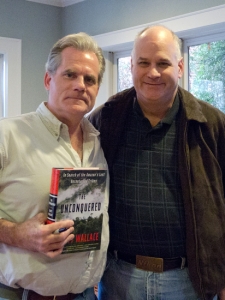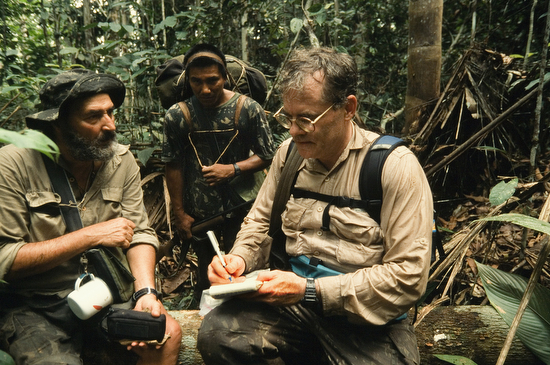 |
| Scott Wallace, National Geographic writer, talks to Dorie Griggs about his latest book The Unconquered. |
 |
| Scott Wallace with Stanley during his book tour in Decatur, Georgia. |
I had the opportunity to meet Scott Wallace a freelance writer who is regularly published in National Geographic Magazine. Dorie Griggs, my wife, met Wallace through The Dart Center for Journalism and Trauma. Wallace is a Dart Center Ochberg Fellow.
Wallace is on a book tour promoting The Unconquered: In Search of the Amazon’s Last Uncontacted Tribes.
He is working on another coverage for National Geographic with photographer Alex Webb.
I asked Wallace a few questions which I thought you might want to know about.
Keep your gear dry
His first tip is for those traveling in rain forest or extremely high humidity locations. It is important to keep your camera dry as possible. He recommends taking a water proof case like the Pelican 1504. You will want to buy some Silica Gel packs that you put into the case. You can put it in your oven at 300 degrees for about 3 hours to dry out the Silica or just put it next to the campfire to help dry it while on location.
Whenever you go to bed, put the cameras in the case to help dry them out each night.
 |
| National Geographic writer Scott Wallace interviews Sydney Possuelo while on expedition in the Javari Valley Indigenous Reserve, Brazil. © Scott Wallace |
Get Permission
Another tip is to get permission of the subjects before photographing them. This is not always put in a question to the subject, but by being aware when they don’t want you to photograph.
Over time you will become more aware of their body language which is telling yes or no. The other thing is to be aware of the local culture. Wallace often asks his guides about the local protocol before taking photos.
As a general rule you are seeking to remain in good social standing so the indigenous people will want you to stay. This is very important for the National Geographic writers and photographers, because they are not like a tourist and just popping in and out. They plan to stick around for a few weeks or even months to get the story. Even if they are not coming back to this location their reputation of how they work will spread quickly through the region one way or another. They need a reputation in the community to be positive.
 |
| Matis scout Kwini Montac © Scott Wallace |
Patience
Wait for your turn. We learn this in kindergarten, but I think sometimes writers, photographers and videographers who work together need to be reminded of this basic respect for others.
While we might like the writer to stay out of our shots, we need to wait our turn and sit quietly through interviews. While some may see this as a time to day dream or do something else, I can tell you from my experience the best photographers learn to listen.
After the writer is finished I might then ask a few questions myself that the subjects comments made me think about.
Take this time to make either a mental note or actually write down all the possible visuals you hear during the interview.
 |
| Kanamari returning from the hunt (Márcio center, Wilson at right) © Scott Wallace |
I find that when I work with a writer on a story, I prefer first letting the writer interview the subject while I listen and maybe make some photos of them talking during the interview. I want to listen as much as I can, because this will lead to better photos.
 |
| The book is available through Amazon as hardcover or Kindle eBook. |
